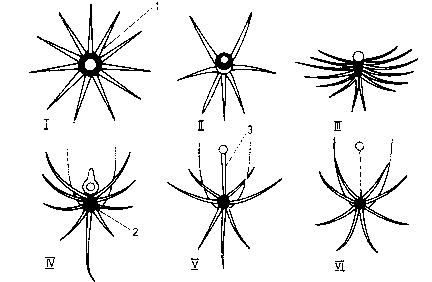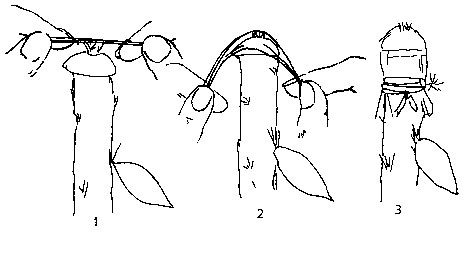PROPAGATING CACTI WITH AREOLES
by G.Krastinya, Riga, Latvia Republic (in brief)
It sometimes happens that the last species of a valuable cactus dies and it's impossible to rescue it as only a thin and weak part of the plant remains. It's no good trying to graft or root it. This situation made us look for new ways of rescuing dying plants. We found it by accident when the only species of Neochilenia malleolata (F. Ritter) Backeb was dying. Only several tubercles with areoles remained healthy. As we were grafting seedlings on Peireskiopsis we decided to try grafting healthy areoles on it. The results were amazing. All the grafted areoles took roots and in a month they gave new plantlets that grew well and the next year two of them even bloomed. The same year we succeeded in grafting areoles of two species of Coryphantha onto Peireskiopsis. We haven't found any data about propagating cacti by grafting areoles onto Peireskiopsis in special literature. Separate papillae of Mamillaria plumosa A. Weber. are grafted onto Peireskiopsis spathulata (Otto). Britt. et Rose. Glase and Foster point [2] that when they grafted Mamillaria meleleuca a new plantlet arose near the basis of the papillae not from the areoles. The author doesn't mention what species is the stock but judging by the photo it may be an Eriocereus jusbertii. He also says it's a good method of propagating rare species if one doesn't want to behead the plant.
The schemes of types of areoles are shown at picture 1.
 |
| Photo 1. Types of areoles (according to Booksbaum [with changes): / - theoretical radial areole; // - twosided ordinary areole: /// - oblong areole with a crestlike arrangement of spines; IV – growing point near the upper part of areole in a groove (Hamatocactus), V – growing point and areole came apart but are still connected by the groove (type Coryphantha)', VI - growing point and areole came apart completely (type Mamillaria). 1 – growing point; 2 – a part of areole with spines; 3 -groove. |
When propagating cacti by areoles take into consideration the location of growing point in the areole (as it is the only point where a new plantlet can start) and the activity of growing points in the areole. Meristematic tissues of young areoles are more able to form new plants than old ones. Nevertheless, even very old areoles of some species can give not only spines but also lateral shoots and flowers. Unfortunately, detailed information concerning the activity of growing points of areole is unavailable yet. Only gradual accumulation of data will allow judging of it within different genera and species of cacti.
To wake up meristems in areoles it is necessary to give them an impulse (usually it means to behead the cactus) which makes for active inflow of nutritive materials.
Grafting cacti on stocks with good roots also makes growing points wake up. This is especially true for the cacti grafted on Peireskiopsis.
Cactophiles achieved remarkable results in propagating rare plants beheading them in the conditions fit for Peireskiopsis. An areole grafted on Peireskiopsis yields to the stock's stimulant action.
For grafting, one cut out an areole with a piece of tissue of tubercle or rib. The thickness depends on the peculiarities of the species and is 2-5 mm. The areoles were grafted on the upper part of the stem of Peireskiopsis, 3-6 cm from the top. It's rather difficult to graft areoles on the very top as their diameter is larger than that of Peireskiopsis. The spines of the areoles were cut out with the scissors as it's almost impossible to fix the graft without doing it. We used a thin medical rubber and elastic thread to fix it. (pic. 2)
 |
| Photo 2. Fixing areole on the stock. |
As the growing point is in the upper part of the areole the cut off piece of graft should be put on the stock so that the zone under the growing point be on the circle of conductive tissues of Peireskiopsi. It makes for developing system of conductive tissues between graft and stock.
The grafted plants were placed into a closed hotbed at 20-35°С. When active growth of the graft was observed the plants were moved onto the shelves of greenhouses.
DISCUSSING RESULTS
Areoles of 36 genera were successfully grafted. The best results were obtained by grafting areoles of Neochilenia plants. Areoles of all eight proved species in this genus gave plantlets. Similar results were obtained also within the genera Coryphantha, Islaya, Neoporteria, Oroya, Sulcorebutia, only the amount of proved species in these genera (2-3 sp.) excludes the possibility to estimate the properties of the whole genus. Areoles of most species which did not give new plantlets were grafted in September or the beginning of quiescent period. It is partly proved by the fact that the areoles of Copiapoa barquitensis did not give new plantlets when grafted in September, but gave 3 plantlets out of 6 areoles grafted in May.
Various results were got after grafting Echinocereus, Echinofos-sulocactus, Mamillaria, Notocaclus и Parodia. If we look at Е. capiogonus and Е. violaciflorus only their upper areoles gave new plantlets after grafting. The areoles of Е. captogonus and Е. violaciflorus though partly took and became fuzzy (which preceded developing new plantlets of other species) did not give new plants. I should say that the areoles of Е. captogonus did not give new plantlets even after the beheading of the graft on a strong stock of Peireskiopsis. New plantlets arose around the central cylinder of conductive tissues. We also observed this phenomenon with some of Roseocactus grafted on Peireskiopsis and with young seedlings of Astrophytum asterias on own roots after they were beheaded for grafting. We grafted areoles of two colored forms of Gymnocalycium mihanovichii on Peireskiopsis too. They took well, gave new shoots, but the young plants turned to be unstable and died during the winter. The dynamics of developing new plants was determined by the biological activity of the growing points of the areole. The areoles of the species that develop lateral shoots well gave new plants quicker after grafted on Peireskiopsis than those of which developing lateral shoots is untypical. The dynamics of developing new plants shows that the activity of the growing points of areoles is different. Neochilenia uanbaein gave new plants almost simultaneously. The rest of the species gave plantlets gradually.
Examining cuts of grafted areoles showed that the right position of areoles on the graft is an important factor for waking growing points. On picture 6 the growing point of grafted areole is above conductive tissues that makes for quick developing a single system of conductive tissues and consequently for waking the growing point and growing of a new plantlet. So, grafting separate areoles of cacti on the stock of Peireskiopsis spathulata (Otto) Britt. et iRose have good prospects for propagating rare plants, for rescuing dying plants, or when it is necessary to obtain in a short time great number of genetically similar plants. Best results were obtained with the grfats of areoles of Coryphantha and Neochilenia as well as Islaya, Neoporteria, Oroya, Sulcorebutia.
The structure of areoles should be taken into consideration at grafting. A tubercle, a piece of rib or mamilla with areole should be placed on the stock so that the growing point of the areole be above the conductive tissues of the stock.
Summary
50 taxa from 22 genera of the family Cactaceae were grafted on the stems of Peireskiopsis spathulata (Otto) Britt. et Rose to prove the possibility of propagation of cacti by grafting separate areoles. The areoles were cut with thin layer of plant tissue and attached by thin medical rubber. The best results were obtained by grafting areoles of Neochilenia plants. Areoles of all eight proved species in this genus gave plantlets. Similar results were obtained also within the genera Coryphantha, Islaya, Neoporteria, Oroya, Sulcorebutia, only the amount of proved species in these genera (2-3 sp.) excludes the possibility to estimate the properties of the whole genus. Different results were acquired with the genera Copiapoa, Echinocereus, Echinofossulocactus, Mamillaria, Notocacius and Parodia. The plantlets arose from new areoles better than from old ones. No plantlets were obtained, from grafted areoles in such genera as Astrophytum, Espostoa, Krainzia, Matucana and Phellosperma, but the grafting in September might be the reason of our failure in this case. The method of propagating cacti by grafting areoles may be of great importance for propagating rare plants, for rescuing dying plants, or when it is necessary to obtain in a short time great number of genetically similar plants.
Literature
- Buxbaum F. Morphology of cacti. Sect1 Roots and stem. Pasadena, Calif.,Abbey Garden Press, 1950.
- Glass C., Foster R. Will's new. - Caclus Succuient J., 1978, vol. 138.
Material by Dm. Petrov, Voronezh, Russia





